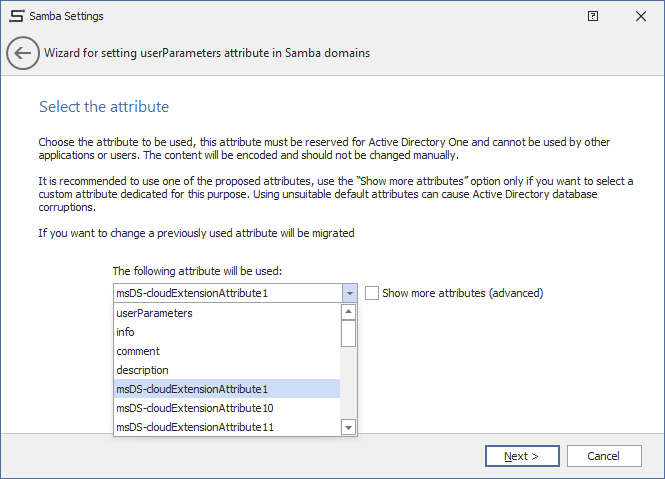|
<< Click to view the table of contents >> Navigation: Commands > Backstage > Application >
|
The Samba Settings feature allows the application to be configured to use an alternate Active Directory attribute to the UserParameters Attribute in domains emulated by Samba. This is necessary because Samba does not support changes to the userParameters attribute via LDAP. The feature ensures smooth integration with Samba domains while maintaining compatibility with the core functionality of the application.
In a domain where controllers consist of Windows Server machines, this command is not visible. When the application detects that the domain contains at least one emulated Samba Domain Controller, a dialog box called Samba Settings is automatically shown. You can also access this box manually in the Backstage in the Application -> Samba Settings menu. If you switch from a domain with Samba Controllers to a domain with Windows Server Controllers, The Samba Settings command remains visible as long as the chosen alternate attribute is other than userParameters. If you re-run the configuration and migrate from the alternate attribute to userParameters the Samba Settings command will no longer be visible.
In the Samba Settings dialog, the user can choose a string-type attribute to use instead of userParameters. The available attributes are:
•msDS-cloudExtensionAttribute1 up to msDS-cloudExtensionAttribute20
•extensionAttribute1 up to extensionAttribute15
•info, description, notes, pager, telephoneAssistant, comment
The user can enable the Show other attributes checkbox to access a complete list of string attributes present in Active Directory, including any custom attributes. In this regard, it is important to point out that care must be taken when choosing which attribute to use. Choosing an unsuitable attribute, such as one used by other applications, or a system attribute may compromise the functionality of Active Directory.

Once the attribute is chosen, the application performs the following checks on all users in the domain:
•If the attribute contains uncoded values, they will be deleted.
•If the attribute contains already encoded values, the application will recognize them, preserve the existing encoding structure of third-party applications, and initialize application-specific properties.
•The application will inform the user about the status of existing values and changes that will be made.
If the user accepts the changes, the application will execute:
•Deleting Uncoded Values: All unencoded values in the selected attribute will be removed.
•Preservation of Coded Values: Compatible and coded values from third-party applications will be retained.
After confirmation, the selected attribute will be used by the application for all operations.
The application supports the migration of values from one attribute to another. To perform this operation:
1.Open the Samba Settings dialog again.
2.Select a new attribute.
3.Confirm the migration.
The application will automatically copy all encoded values from the previous attribute to the new one, ensuring that no data is lost.
The selected attributes must be single strings and not multivalue.
Ensure that the selected attribute is not used by other applications or policies in the domain.
The feature is designed to minimize unwanted changes, but it is always recommended to back up the domain before making significant changes.
If you are experiencing problems using Samba Settings:
1.Check that the selected attribute is accessible and writable.
2.Check that there are no policies or restrictions preventing the attribute from being changed in the domain.
3.Contact technical support providing details of the error encountered.
See also: UserParameters Attribute - Extra attributes